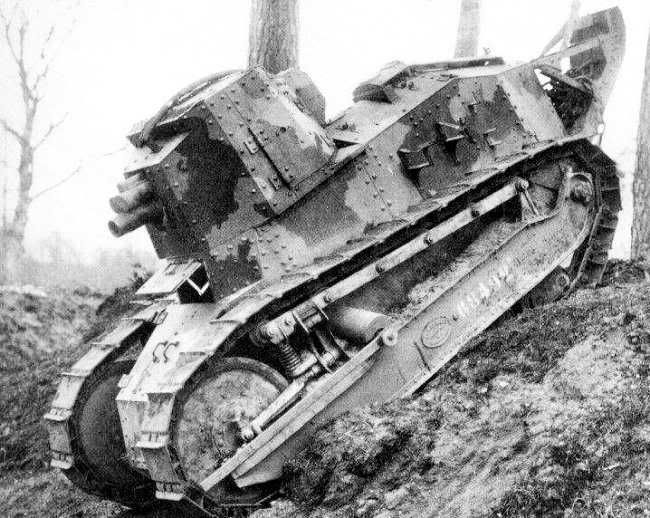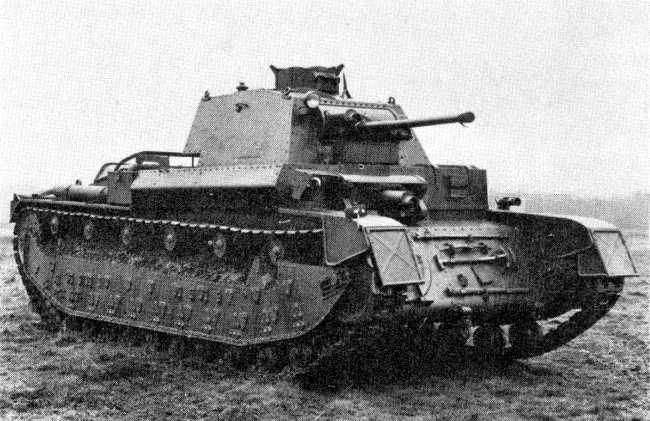PZInz 32TP wzór.44 and wzór.46 "Lwica"
The 32TP wz.44 tank was designed by PZInz as a replacement for the 26TP wz.42, itself a heavily-modified variant of the German Panzer IV tank. The 32TP was designed to provide superior firepower and protection in comparison to the 26TP. An 85mm gun, based on an anti-tank gun prototyped in 1942, provided enhanced firepower in comparison to the previous 75mm guns used on Polish tanks.
Development
The adoption of the 26TP wz.42 - a final variant of the German-designed Panzer IV - caused a significant social backlash between the Polish government and industry, as well as within the Bron Pancerna. Although Poland's industry had not produced a viable and modern medium tank design, the adoption of the German tank was widely the source of significant disgust to Polish nationalist movements, who felt that the country had the industrial capability to design and build a well-regarded medium tank that could be exported to other Eastern European armies. Additionally, the Bron Pancerna felt that the 26TP design did not have any modernization potential sufficient for a long service life. In 1942, the Bron Pancerna, under the leadership of General Stanislaw Maczek, directed PZInz to begin a new design project to produce a more modern medium tank to serve as a generational follow-on to the 26TP, incorporating more indigenous parts.
In January 1943, PZInz submitted two alternative designs, designated
Alt 2 and
Alt 3, to the Bron Pancerna for final approval. (The
Alt 1 design, a tank of 28 tons with a 75mm gun, was rejected earlier in the development cycle.) Both alternatives were armed with a high-velocity 85mm/L55 gun and were estimated to weigh in at 32 metric tons. The Bron Pancerna rejected Alt 2, a design with a rear turret and central engine, objecting to the use of untested or prototype automotive components, as well as concerns about maintenance due to the central engine. The Alt 3 design, a scaled-up version of Alt 1, was selected for further development, although a series of changes were required; the vehicle was shortly thereafter designated the 32TP.
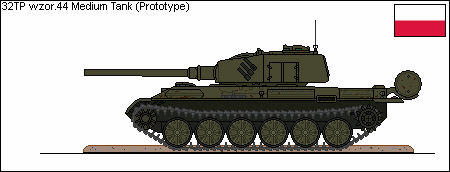 The 32TP wzór.44 Prototype, as presented to the Polish Army
The 32TP wzór.44 Prototype, as presented to the Polish Army
A first prototype of the 32TP was constructed in spring of 1943, and was demonstrated throughout the summer. The prototype had a welded hull with a well-sloped frontal glacis, a cast turret, and a transverse engine mounting similar to that of the Russian Federation's T-44 tank, which appeared at approximately the same time. Polish intelligence became aware of the T-44's transverse engine design sometime during 1943, but it was never clear if the Russian tank influenced PZInz's use of the same feature on the 32TP. However, as on the T-44, the use of this feature resulted in a generally improved layout and a lower profile for the tank.
Most castings for the tank were provided by Huta Ludwików (also known as SHL).
Features
Layout
The tank had a fairly standard layout, with the driver centrally located in the forward hull (with a top-opening access hatch), and three crewmen (gunner, loader, and commander) in the turret. The gunner and commander were seated on the right side of the gun in the turret, while the loader was seated on the left. The loader had access to a two-piece hatch in the side of the turret that allowed for ammunition loading; the gunner had a simple one-piece hatch in the turret roof.
Mobility
The 32TP used a torsion-bar suspension with six rubber-tyred road wheels and no return rollers. The tank had decent ground clearance, slope-climbing, and trench-crossing capabilities; a power-to-weight ratio of 18.75 hp/tonne gave it excellent cross-country performance in all conditions.
During the design process, PZInz attempted to find a Polish-developed engine, but it quickly became clear that no indiginous petrol or diesel engine had enough horsepower or reliability for the job. A newly-developed engine was hypothesized but quickly discarded as too expensive. However, through their ties with the French firm of Alsthom, PZInz's Ursus factory was able to provide a locally-manufactured (and slightly modified) version of the Alsthom/SACM MD.12/36 tank powerplant, a 36-litre V-12 diesel engine that could provide 600hp; the engine was called the Ursus Jelen ("Stag") in Polish production.
Protection
The hull of the 32TP was welded, with a well-sloped frontal glacis; the turret was centrally located in the hull. The glacis had an overall slope of 60°, with a thickness measuring between 40mm and 90mm. The sides varied between 30mm and 75mm, with no sloping.
The 32TP's turret was originally developed as a prototype for the preceding 26TP wz.42, but was scaled up slightly for the 32TP's turret ring and the 85mm armament. The turret face had a thickness of 120mm. The turret face had no substantial sloping, but much of it was covered by an additional 40mm gun mantlet, and the turret profile was low and relatively narrow.
Firepower
While the preceding 26TP wzór.42 used a licensed variant of the German KwK 40 L/48, the 32TP was intended to use a larger 85mm gun of Polish derivation. The final gun was designated the 44U-BA, with an 85mm bore size and a length of 55 calibers. At the time of its introduction, it was one of the most powerful tank guns in Europe. The 44U-BA had a number of visual similarities to the German KwK 40; the two guns were manufactured in the same factory using German-tooled equipment originally purchased to license-manufacture the Polish KwK 40. However, the breech lock showed distinct differences, and the 44U-BA had no muzzle brake. The 32TP's low-profile turret design restricted the maximum gun depression to -6°, which was deemed workable if not particularly outstanding. Zeiss optics were purchased from Germany for the main gunnery sight.
In mid 1946, the 32TP received the upgraded 44U-BE4 main gun, which increased the barrel length to 62 calibers, a move intended to improve the gun's antitank performance. Additional weights were added to the load end in order to maintain balance, and improved aiming
Ammunition was carried low in the tank, with two wet stowage racks, each holding twenty-seven rounds, located at the bottom of the turret. Four more 'ready rounds' were located near the loader's position, for a total of fifty-eight rounds. While one wet stowage rack was located under the loader's position and was easily accessible, the second wet stowage rack was harder to access.
A coaxial 7.92mm machine gun was originally placed in the turret, next to the main gun, but it interfered with the working room available to the loader, and it was removed from production tanks by December of 1944. A hull machine gun was also originally planned, but removed prior to the beginning of production. This left only the pintle-mounted machine gun located on top of the turret. The Polish Army preferred to use an air-cooled derivative of the Wz.36 machine gun manufactured by Panstwowa Fabryka Karabinow. Export tanks built for Bulgaria used a variant of the Russian SG-43 Goryunov machine gun, license-built by DVF Kazanlak and chambered in 7.5x55 Swiss.
Other Features
Gundlach tank periscopes were provided for the use of both the commander (who had six) and the driver (who had three), allowing for an excellent degree of visibility around the tank when buttoned up.
Beginning in 1946, a pair of small ventilation fans were added in the turret to help remove fumes from firing the main armament. Two sets of three 81mm smoke grenade launchers were placed on the sides of the turret, and a K6 smoke generator was installed from December 1944 onwards.
Service
The Bron Pancerna evaluated six pre-production vehicles during February and March of 1944 prior to giving final approval to the design in April. The design was given the official designation
32TP wzor.44 (usually shortened to "32TP" or "Wz.44"). Manufacturing started at a low level in May, and the first vehicles were delivered to training units in September, two months later than the June date originally desired by the Polish Army.
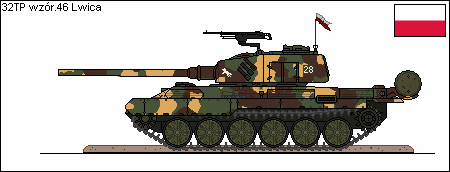 A 32TP wzór.46 Lwica in standard Polish summer camouflage.
Variants
A 32TP wzór.46 Lwica in standard Polish summer camouflage.
Variants
Production was undertaken in a number of batches, each of which incorporated a number of improvements and variations. As a result, three major variations appeared through the 32TP's production run.
- 32TP wzór.44/A. The initial production model, built from May 1944 to December 1944. This version could be distinguished by the inclusion of a coaxial machine gun in the turret, firing through a hole in mantlet on the left side of the gun. Seventy-four vehicles were built, including twenty-four export vehicles for Bulgaria.
- 32TP wzór.44/B. An improved variant built between December of 1944 and June 1946. Introduced almost two hundred minor engineering changes designed to ease manufacturing or lower cost. Among the largest improvements was the removal of the coaxial machine gun and the addition of the K6 smoke generator. Internally, wet stowage racks were installed for the ammunition, and improvements were made to the loader's working space. Sideskirts manufactured from 10mm steel plates were added to the vehicle to prevent dust from interfering with the crew while moving.
- 32TP wzór.46 "Lwica". An enhanced version that entered production in June of 1946. The largest change to the 32TP wzór.46 was the adoption of the longer-barreled 44U-BE4 gun (85mm/L62) and the installation of an improved gunlaying system. At the same time as the introduction of the improved gun, a new 85mm HEAT shell was introduced to service. Other updates were made to the fuel pumps, the winterization gear, and the fire controls. A number of small armour changes (due to the adoption of different castings) raised the vehicle's overall weight to 35 tonnes. The new variant was named the "Lwica" (Lioness). By the end of 1947, this name sometimes was applied incorrectly to older variants of the tank of the tank.
- 32PP wzór.46 Kobra
PZInz worked on a set of three variants, including a casemate tank destroyer armed with a 100mm gun, an air-defense tank with twin 37mm Bofors cannon, and a self-propelled artillery piece. As design work progressed, serious issues with the self-propelled artillery design became apparent, and further design work was cancelled in 1945. A prototype of a 100mm-armed casemate tank destroyer was constructed, but despite interest from the Polish and Bulgarian armies, no orders for this type were placed. Ultimately, the only one of the three major variants ever built in any numbers was the 32PP wzor.46 (for pojazd przeciwlotniczy), or 'Kobra'. An open-topped turret with twin 37mm guns was mounted on an otherwise-standard 32TP tank hull.
- Engineering Vehicles
A number of armoured engineering vehicles were constructed on the basis of the 32TP hull. In most cases, this involved replacing the turret with a rotating platform with a crane, installing a heavy-duty dozer blade on the front, and placing a digger attachment on the left rear side of the tank. A bridge-laying variant was also constructed, although most 32TP bridgelayers were converted from older worn-out tanks later in their service lives.
Export Users
Bulgaria
In late 1943, the prototype of the 32TP was shown to senior officers of the Bulgarian tank arm during a tour of the PZInz plant. The Bulgarian Army's General Directorate of the Mechanised Forces (GDMS -
Glavna direktsiya na mekhaniziranite sili) was immediately interested in the design and signed a memorandum of understanding with PZInz to purchase at least sixty tanks upon the start of production. Bulgaria contributed money to the development effort through 1943 and 1944, but the Bulgarian Ministry of Defense demanded a number of design changes, including the use of some Bulgarian-manufactured parts. This annoyed PZInz and the Polish government, which were already setting up the manufacturing line. Further, PZInz raised doubts about the quality-control of Bulgarian parts. The two parties, after some ongoing disagreement, agreed to use Bulgarian-sourced parts only on the tanks ordered by them. PZInz's concern about quality-control was well-justified, and the Bulgarians withdrew most of their requirements for their follow-on orders. However, once the Bulgarians received their first tanks, they developed solutions to two of the most problematic issues with the 32TP, fixing the defective cold-weather starter system and developing an improved fuel pump. The Polish Army in turn adopted these solutions over the course of 1946, eventually incorporating them back into production with the 32TP wzór.46 variant.
The vehicle was designated the T44/85 in Bulgarian service. Bulgarian T44/85s could be visually distinguished by their use of a licensed SG-43 machine gun mounted on the turret roof, alternate engine grills, and a lower-mounted detachable fuel drums on the rear of the tank. Starting in 1946, Bulgaria switched over to use Russian-supplied Protsion radios, refitting them to all Bulgarian vehicles. The Bulgarians also applied a flame-retardant cloth lining to the interior of the crew spaces to serve as a spall liner.
By the close of 1947, Bulgaria had ordered 258 tanks:
-- T44/85A1 (32TP wzór.44/A): 24x
-- T44/85A2 (32TP wzór.44/B): 174x
-- T44/85A3 Luvitsa (32TP wzór.46 Lwica): 60x
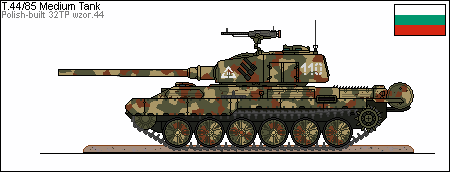 Bulgarian T44/85 (A3) in "Thracian" camouflage.
Romania
Uncertain - probable export user; Romania was very interested in buying 32TPs at one point, but may have selected the Standardpanzer Panther instead.
Others
Bulgarian T44/85 (A3) in "Thracian" camouflage.
Romania
Uncertain - probable export user; Romania was very interested in buying 32TPs at one point, but may have selected the Standardpanzer Panther instead.
Others
Poland offered to sell the 32TP to the Latvian Army, which instead elected to purchase German Standardpanzer Panthers in 1947. Armenia also showed interest in the design, but the purchase fell through due to economic reasons when the French acquired a copy of the official Polish sales proposal, and undercut them with an offer to supply refitted AMX-34 Montbrun medium tanks.
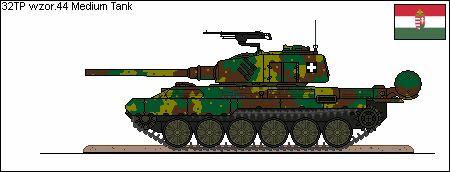 One of the four 32TP wzor.44s as demonstrated to the Hungarian Army
One of the four 32TP wzor.44s as demonstrated to the Hungarian Army
Over the course of 1946, the Hungarian Army expressed interested in license-building the 32TP in order to replace their fleet of secondhand German Panzer IVs. In early 1946, four 32TPs were delivered to the Hungarian Army for evaluation and training. However, at the last moment, the Hungarian government received an alternative offer to pick up, for a lower price, Switzerland's stake in the Czech TVP vz.47 project. Although some negotiations continued between Hungary and Poland for nearly a year afterward, Hungarian interest slowly evaporated. All four tanks were officially retained by Hungary, although one was surreptitiously 'loaned' to Czechoslovakia during 1947 for technical evaluation.
Specifications
Dimensions:
-- Length: 6.07 meters (hull), 7.65 metres (with gun)
-- Width: 3.25 meters
-- Height: 2.5 meters
Weight: 32 tonnes, eventual rise to 35 tonnes
Armament:
-- 44U-BA 85mm/L55 gun with 58 rounds; later 44U-BE4 85mm/L62 gun
-- Pintle-mounted MG on turret roof (for commander)
-- 6 x 81mm smoke grenade dischargers
Engine: Ursus V12 'Jelen' diesel, 600hp (licensed Alsthom/SACM MD.12/36)
Transmission: Manual, 5 speeds forward and reverse
Suspension: Torsion bar with six road-wheels
Protection:
-- Turret face: 120mm
-- Glacis: 40mm-90mm (sloped at 60°)
-- Sides: 30mm-75mm
Power to Weight Ratio: 18.75 hp/tonne (drops to 17.14 hp/tonne with later models)
Speed: 53 km/h (road), 25 km/h (offroad)
Range: 350 km (120 mi) with 500 litres fuel
Constructors: PZInz
Advantages:
-- Good overall balance of mobility, firepower, and decent protection on a combat weight of only 32 metric tons
-- Low profile
-- Inexpensive to purchase and operate
Disadvantages:
-- Poor gun depression of -6°
-- Mediocre frontal protection on the turret
